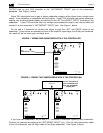
THX subwoofers page 7
For the V-125THX, the "CALIBRATED" level is 4 dB lower than the "THX" level (switch set to "THX").
Set the control to this mark if you have only one subwoofer in the system (such as in a very small room).
On both the MX-150
THX and V-125THX, the +2 and +4 marks indicate the points where your
subwoofer is producing 2 dB and 4 dB more output than the "CALIBRATED" level.
SETTING SUBWOOFER LEVEL (THX)
The proper method of setting the level of the subwoofer in THX mode is to use the low frequency
pink noise test signal generator built into the THX controller and a sound level meter (available from
Radio Shack). First set the master volume of the THX controller to the "0" or "REF" position. Then
set the Subwoofer Output control on the THX controller so that the output of the subwoofer causes
the sound level meter to read 75 dB (C scale, slow mode) when that test signal is playing. All channels
of the THX system should be calibrated to this 75 dB level when using the unit's internal test signal.
Special Note: When calibrating the subwoofer level (and only the subwoofer level), you will find
that the needle on your sound level meter will bounce plus or minus a couple of decibels when
measuring the test signal. To set subwoofer level, read the AVERAGE meter level, not the peak level.
Move around the room as you measure levels, so that your measurements account for the room
reinforcements and cancellations found at various room locations.
For details on setting levels with your THX controller, see the instructions provided with that unit.
USING TWO SUBWOOFERS (THX)
SPECIAL NOTE: If you have the V-125
THX subwoofer, you must use two in your system to meet THX
requirements. If you have the MX-150
THX, only one is required to meet THX specifications.
Using two subwoofers in your THX system will give you the ultimate in bass performance. It will give
you improved bass impact and definition, as well as greater output and dynamic range. If you locate
the subwoofers in different parts of the room, you will get a better overall frequency response,
because the room modes excited by one woofer are complemented by the presence of the other
subwoofer. Alternately, if you stack two subwoofers, one on top of the other, their outputs will couple
and give you an additional total of up to 6 dB of output.
Wiring with two subwoofers is simple. Instead of running two interconnect cables to one subwoofer,
run one interconnect to each subwoofer, using each LEFT/MONO input jack. See Figure 2 (page 5).
6. OPERATION WITH A NON-THX PROCESSOR
OPERATION OF THE "LOW PASS FILTER" SWITCH
With a non-THX controller, preamp, etc., this switch should be set to the "80 Hz 24 dB/OCTAVE"
position. Do not operate this switch unless the "BASS LEVEL" control is set to "MIN."
For use with non-THX systems, your subwoofer has been optimized for an 80 Hz crossover with
a 24 dB/octave slope. This low pass filter makes a rapid transition to 36 dB/octave above 125 Hz,
which provides the extremely sharp attenuation needed to make the subwoofer's sound non-
directional.
For optimal performance, we strongly recommend that you use an M&K HP-80 High-Pass
Filter. Your subwoofer with this filter and M&K Satellites forms a 4th order Linkwitz-Riley crossover
between satellite and subwoofer. The linear phase of this crossover means uncompromised
performance with great flexibility in system setup without elaborate calibrations or adjustments.


















